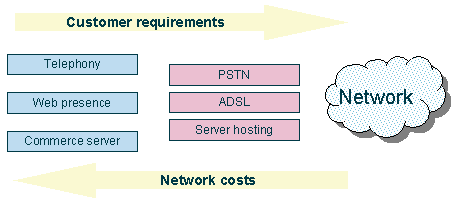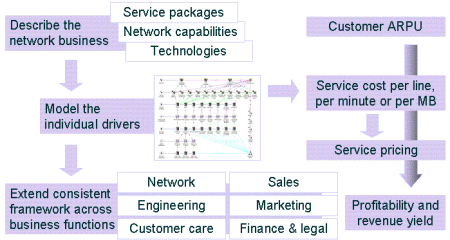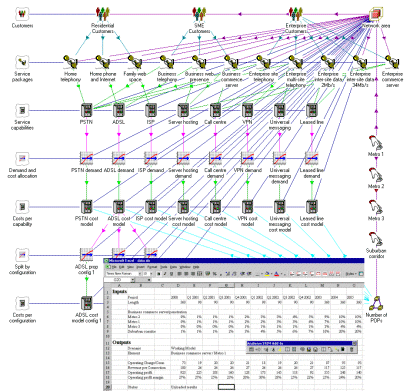Every responsible carrier business should be measuring the unit costs of the services
it provides as a critical benchmark for determining a pricing strategy for long-term
survival. Market-driven tactical pricing must be balanced with the fundamental requirement
to cover costs with a core margin in the long term.
An integrated service provider may deliver tailored solutions to customers in a
variety of service packages, drawing on core capabilities in PSTN, Internet, and
data connectivity. Understanding the underlying costs, and especially the common
network costs (the synergy which defines the modern carrier business) will depend
critically on the ability to relate each separate offering into a common, manageable
and forward-looking network cost model.

While enabling an operator to evaluate the impact of multiple pricing scenarios
on its short-term cashflow and long-term profitability, the STEM network modelling
system also automatically calculates the unit costs of all services provided on
a telecoms network, broken down at the modeller’s discretion into access costs per
line, backbone network costs per Mbyte or simply total costs per minute.
The investment ventured…
STEM is optimised towards the rapid development of service costing models, enabling
the modeller to develop a high-level, GUI-driven view of the network business structure
in the following steps:
- Describe the network business in terms of the service packages offered to customers,
the underlying network capabilities which carry those services (such as PSTN, Internet
or server hosting), and then the specific technological configurations employed
in the network.
- Model the individual factors which relate the connection and traffic load on the
network to the physical infrastructure, making critical allowances for geographical
deployment, forward planning, overhead capacity and redundancy.
- Extend the cost and revenue analysis to capture the human and administrative functions
of the business within the same consistent framework, factoring in the economic
value of these functions and some elasticity of demand with respect to perceived
quality of service.
- Use a simple ARPU model to short-circuit the complexity of discounted calling schemes
and bundled-minutes packages and focus directly to the reality of users’ spending
constraints and the implications for the business model.

Service costing process
STEM is closely integrated with Excel, allowing the analyst to exploit the power
of the latest STEM template replication facility to automatically reproduce this
modelling concept across separate regions or network areas for greater segmentation
and accounting separation, while keeping the inputs and outputs compact and accessible.

Illustrative layered network STEM model, integrated with Excel
…and the insight gained
Unlike an OSS-driven costing exercise, which may deliver unchallenged accuracy and
detail in the current or recent costs of a network, STEM links forecast demand scenarios
directly to forward-looking revenue and cash projections:
- Measure the sensitivity of future profitability to variations in actual service
take-up on the basis of adaptable month-by-month model outputs up to 24 months ahead.
- Explore the potential for increased revenue yield on the fixed asset base of the
existing business through the re-configuration of service packages and the underlying
network.
- Evaluate offline the implications of tentative cost-cutting programmes, using product
and customer profitability metrics to balance engineering and service objectives.
STEM’s intrinsic cost-allocation mechanism automatically associates network costs
with those services which require the corresponding capacity. Where multiple services
share the same capacity, costs are allocated in proportion to demand by default.
Optionally, and on an individual element basis, these proportions can be artificially
weighted, or driven by revenue rather than demand. This causal model provides an
insightful framework for determining the impact of future strategic decisions, complementing
activity-based costing analysis:
- Determine robust benchmarks for service pricing decisions based on fully-allocated
and activity-based cost results, plus new direct-cost results under development
designed to identify the cost of the efficient network for optimal competitive pricing.

Illustrative STEM results
Our expert practitioners can develop these ideas as they apply to a business, working
closely with the STEM development team to extend the existing algorithms where necessary
to meet the exacting requirements of our clients.